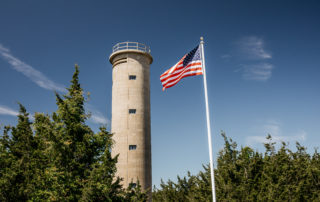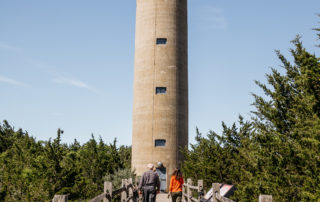Was Fire Control Tower No. 23 used for spotting fires?
No, it was used for spotting enemy ships during World War II and aiming guns to fire on them.
This Fire Tower was part of Fort Miles. So, where was Fort Miles anyway?
Fort Miles was never a building. It was a number of fire control towers, gun batteries, plus barracks and support buildings, on both sides of Delaware Bay. By World War II, the military used a spread-out series of towers and batteries, whose firing ranges overlapped, to protect a large territory. Its largest guns and headquarters were located on the Delaware side (in what is now Cape Henlopen State Park), since the shipping channel hugs the Southern shore of Delaware Bay.
Was Fire Control Tower No. 23 used for spotting submarines?
No, the gun batteries and towers of Fort Miles were designed to destroy German battleships (like the infamous raider, the Graf Spee). Giant underwater nets prevented submarines from entering Delaware Bay. Lurking out in the ocean, submarines were largely invisible from the towers on shore. Instead, it took teams of American aircraft with bombs and naval vessels with sonar and depth charges to track down and destroy the German U-boats.
Were there any other Fire Control Towers?
Yes, there were originally 15 concrete fire control towers, 11 on the Delaware side and four here in New Jersey. Of the four in New Jersey, the ones in North Wildwood and Wildwood Crest have been destroyed, while the one on Beach Drive in Cape May has been engulfed by the Grand Hotel (with only its top visible, sticking above the roof). One of the towers in Cape Henlopen State Park in Delaware has been restored and opened to the public.
Were there any naval battles in Delaware Bay?
No, German submarines sank many merchant vessels off the coast of Cape May. But no German ships ever got up the Delaware River to attack the Philadelphia Navy Yard, Philadelphia or Camden.
Was Fire Control Tower No. 23 built here or prefabricated?
The Fire Control Tower was built here in June, 1942 by using a sliding tube-shaped form. A ring of reinforced concrete was poured. When that solidified, the form was slid up and more concrete was poured. The whole Tower was formed this way except for the top, which required a form of its own. The whole process took only two and a half days.
Was the Cape May area important during World War II?
Yes, the Cape May area was a beehive of military activity during World War II. Cape May harbor had a Naval Air Station, a Coast Guard base and an airport, and Naval Air Station Wildwood (where the County Airport is now) trained aircraft carrier pilots. Cape May Shipbuilders on Wilson Drive, where the Cape May Whale Watcher is now, built Navy tugboats and dredges. The Northwest Magnesite plant, which made an ingredient used in firebricks for steel mills, was located across Sunset Boulevard from Fire Control Tower No. 23.
Why is Fire Control Tower No. 23 administered by the Cape May MAC?
Like the Cape May Lighthouse, Fire Control Tower No. 23 is owned by the State of New Jersey (specifically, the Department of Environmental Protection, Division of Parks). As was the case with the Lighthouse, the State lacks the funds to restore and operate these historic structures. Instead, it has leased them to the area’s leading cultural and historic preservation organization, Cape May MAC (Museums + Arts + Culture). Founded in 1970, Cape May MAC saved and restored the 1879 Emlen Physick Estate and operates it as Cape May’s only Victorian house museum. Starting in 1986, Cape May MAC spent 15 years (and some $2 million) on the restoration of the Cape May Lighthouse.
In 2004, Cape May MAC signed a 20-year lease for Fire Control Tower No. 23. After raising $1.3 million (from the New Jersey Historic Trust, the Casino Reinvestment Development Authority and a Small Cities Block Grant administered by the New Jersey Department of Community Affairs and Lower Township), Cape May MAC restored the Tower in 2008-09 and opened it to the public in April 2009. Cape May MAC is currently raising funds to construct a visitors welcome center for the site.

















